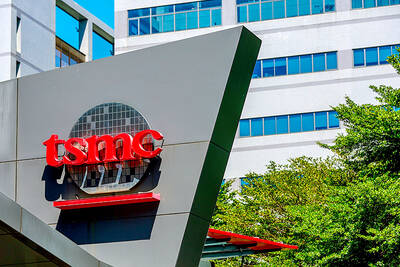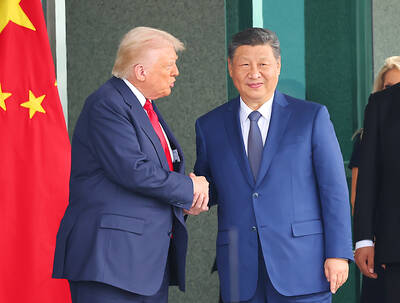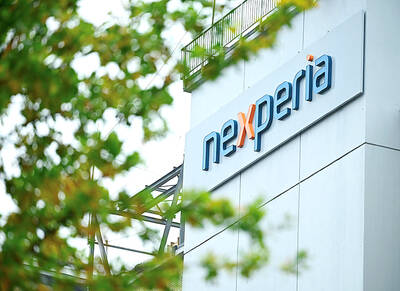Epistar Corp (晶電), the nation’s largest LED chipmaker, expects revenue to be flat this year, but aims to improve its profitability through continued restructuring measures, chairman Lee Biing-jye (李秉傑) said yesterday.
“We would maintain our decision to freeze 25 percent of our total production capacity throughout this year and adjust Epistar’s product portfolio to improve our profitability,” Lee told reporters on the sidelines of the Taiwan International Lighting Show at Nangang Exhibition Hall in Taipei.
Due to the falling average selling price (ASP) of LED lighting products and sluggish demand for backlight units used in TVs, Epistar reported a net loss of NT$3.01 billion (US$93.04 million) last year, plummeting significantly from NT$1.81 billion made a year earlier.
That represented losses per share of NT$2.81 for last year, compared with the previous year’s earnings per share of NT$1.98.
As part of its restructuring plan, Epistar last month announced a plan to reduce its production capacity by suspending the operations of two of its plants in Taiwan and China.
While the move might lead to Epistar’s market share shrinking, reducing production capacity is an effective way to raise its production utilization rate and operation efficiency when the industry faces a supply glut, Lee said.
While implementing better cost structure and streamlining, the company is also shifting its focus to developing more profitable products, while stopping taking orders for those with poor ASP, he said.
On the back of its restructuring efforts and recovering demand for both backlight units for TVs and lighting products, Epistar’s revenue last month expanded 35.97 percent to NT$2.23 billion from February, while gross margin also swung back to positive territory last month, company data showed.
Yuanta Securities Investment Consulting Co (元大投顧) said in a report last month that a key problem facing Epistar is competition for its blue/white LED business from Chinese rivals aided by financial support from the Chinese government.
Lee said demand for Epistar’s LED lighting chips would be stronger than for its LED backlight units this year, as a growing global LED lighting penetration rate would boost demand.
The company’s LED lighting chip shipments are expected to grow from last year, but a low ASP is to remain a challenge for Epistar, he said.
Compared with the outlook for Epistar’s LED lighting and backlight units, Lee said he is more optimistic about the growth momentum of Epistar’s automotive LED chips and infrared applications this year.
Epistar is to introduce new automotive LED applications for the European market this year, and expects to see more revenue contribution from this segment, he said.
The company is upbeat about a growing usage of high-performance infrared applications and is to focus more on industrial-use products with higher margin, instead of infrared applications for consumer use this year, Lee said.
The company’s shares yesterday rose 2.19 percent to close at NT$23.35 in Taipei trading, outperforming the TAIEX, which gained 1.42 percent.

RUN IT BACK: A succesful first project working with hyperscalers to design chips encouraged MediaTek to start a second project, aiming to hit stride in 2028 MediaTek Inc (聯發科), the world’s biggest smartphone chip supplier, yesterday said it is engaging a second hyperscaler to help design artificial intelligence (AI) accelerators used in data centers following a similar project expected to generate revenue streams soon. The first AI accelerator project is to bring in US$1 billion revenue next year and several billion US dollars more in 2027, MediaTek chief executive officer Rick Tsai (蔡力行) told a virtual investor conference yesterday. The second AI accelerator project is expected to contribute to revenue beginning in 2028, Tsai said. MediaTek yesterday raised its revenue forecast for the global AI accelerator used

Taiwan Semiconductor Manufacturing Co (TSMC, 台積電) has secured three construction permits for its plan to build a state-of-the-art A14 wafer fab in Taichung, and is likely to start construction soon, the Central Taiwan Science Park Bureau said yesterday. Speaking with CNA, Wang Chun-chieh (王俊傑), deputy director general of the science park bureau, said the world’s largest contract chipmaker has received three construction permits — one to build a fab to roll out sophisticated chips, another to build a central utility plant to provide water and electricity for the facility and the other to build three office buildings. With the three permits, TSMC

TEMPORARY TRUCE: China has made concessions to ease rare earth trade controls, among others, while Washington holds fire on a 100% tariff on all Chinese goods China is effectively suspending implementation of additional export controls on rare earth metals and terminating investigations targeting US companies in the semiconductor supply chain, the White House announced. The White House on Saturday issued a fact sheet outlining some details of the trade pact agreed to earlier in the week by US President Donald Trump and Chinese President Xi Jinping (習近平) that aimed to ease tensions between the world’s two largest economies. Under the deal, China is to issue general licenses valid for exports of rare earths, gallium, germanium, antimony and graphite “for the benefit of US end users and their suppliers

Dutch chipmaker Nexperia BV’s China unit yesterday said that it had established sufficient inventories of finished goods and works-in-progress, and that its supply chain remained secure and stable after its parent halted wafer supplies. The Dutch company suspended supplies of wafers to its Chinese assembly plant a week ago, calling it “a direct consequence of the local management’s recent failure to comply with the agreed contractual payment terms,” Reuters reported on Friday last week. Its China unit called Nexperia’s suspension “unilateral” and “extremely irresponsible,” adding that the Dutch parent’s claim about contractual payment was “misleading and highly deceptive,” according to a statement